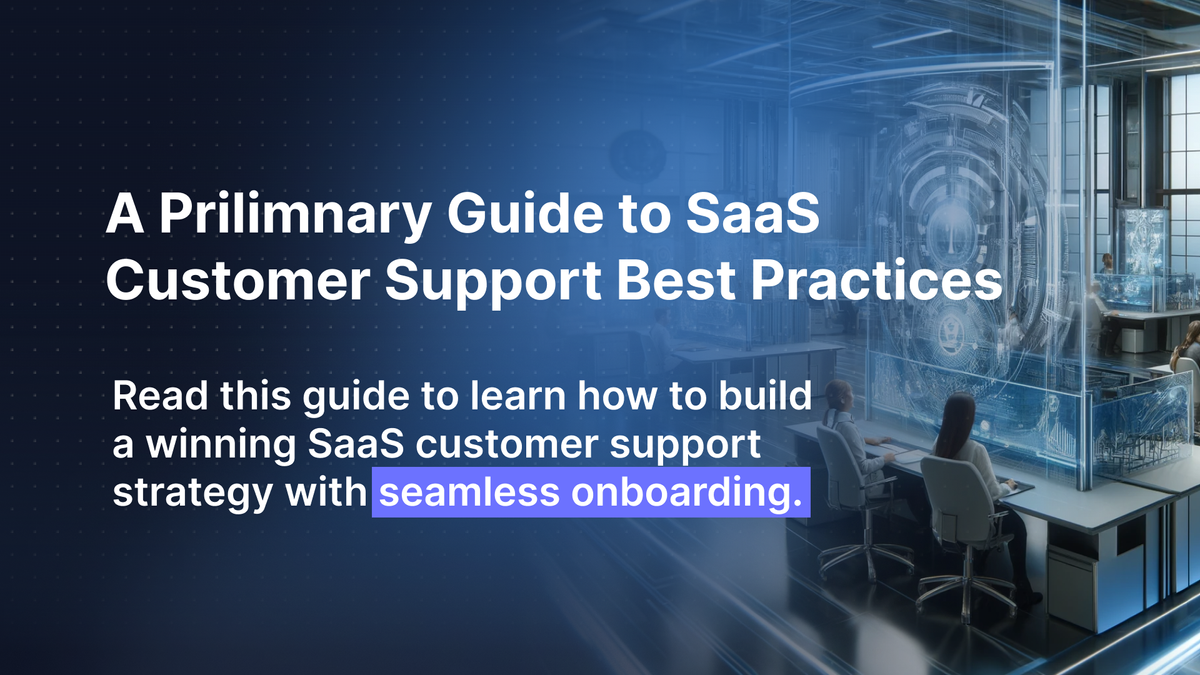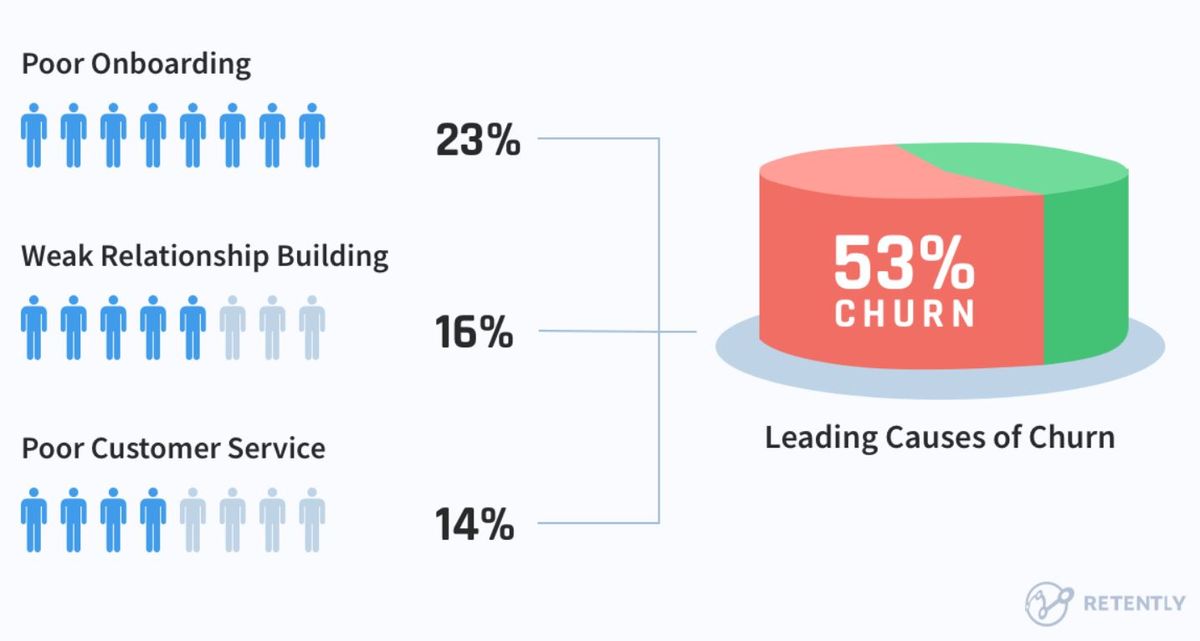Read this guide to learn how to build a winning SaaS customer support strateg...

Customer support is essential for the success of any business, but it is even more critical for SaaS companies. SaaS relies on ongoing subscription models and user satisfaction unlike the traditional sales model. SaaS businesses need to prioritize exceptional customer support throughout the customer journey to keep customers engaged and coming back for more. This is because SaaS products constantly evolve, and users need continuous assistance to get the best out of the software.
In this guide, we will explore SaaS customer support best practices, providing you with the tools to provide unforgettable customer service.
SaaS customer support refers to the guidance and assistance SaaS companies provide (Software as a Service) to their users. It is like having a guide by your side that helps you utilize the software most productively and efficiently.
SaaS customer support goes beyond selling subscriptions or fixing technical hiccups. It is about providing ongoing guidance to ensure users leverage the software in the best possible way.
Whether it is onboarding new users, dealing with troubleshooting or offering best practices, Saas customer support emphasizes building relationships with customers. It bridges the gap and ensures a smooth user experience, eventually leading to better engagement, customer retention, and more business opportunities.
Software as a service (SaaS) is a cloud-based business model that provides different software subscriptions to users over the Internet. SaaS users opt for a paid subscription and can use it from any external server through a web browser. Some of the most common examples are Wordpress, Trello, MailChimp and Salesforce.
Right now, there are more than 30,000 Saas companies empowering millions of users in collaboration, finance, HR, E-commerce and related fields. Let’s see a breakdown of what SaaS customer service typically involves:

SaaS customer service starts even before purchase. This involves answering questions about software’s features, pricing, and how it can benefit the client's business. It may also include free trials and demos to clear any doubts or ambiguity about the software.
Once a user signs up, they are usually provided with tutorials, training guides, resources and even one-on-one sessions to get a solid understanding of how to use the software efficiently.
Technical issues are inevitable. SaaS customer support teams are usually trained in troubleshooting and answering FAQs. They have multiple support channels like phone, email, live chats or ticketing systems.
This is something employees and clients both can benefit from.
It usually includes:
Apart from all these, several Saas customer support best practices, such as proactive support, feedback collection and continuous training and development, can help SaaS companies create a helpful and engaging customer experience.
Customer service is undeniably the most crucial part of any business; a SaaS organization is no exception. The typical SaaS churn is often cited as 5%. A business should aim at around 3% for a good churn rate. This shows that customer support is even more significant for a SaaS business. It's not just support but the lifeline of a SaaS business, and this is because of the unique nature of this business model. Let's see how:
Unlike retail or E-commerce, where transactions are one-time, SaaS relies on subscriptions. Customer support becomes critical to ensure users find ongoing value in the software and keep their subscriptions.
SaaS products are complex and constantly evolving. The support agents need to have exceptional technical knowledge and troubleshooting skills to resolve issues swiftly.
Unlike a product a customer can return, software issues need immediate resolution. SaaS support must be readily available and capable of handling technical issues without putting customers on a long wait to minimize user frustration.
Even the most efficient customer support can’t guarantee success if it doesn't translate into customer growth. A winning SaaS customer support goes beyond fixing glitches and provides users with all the resources and continuous assistance that help them drive growth and revenue for their business.
A successful SaaS customer support strategy is an ecosystem of different components working together to provide an unparalleled customer experience by understanding their pain points and providing the right support at the right time. Here are the five key components to consider:
AI support and automation have now become an integral part of every customer support due to their ability to provide proactive support. AI chatbots act as intelligent filters, handling routing tasks, FAQs and basic troubleshooting around the clock. They can quickly escalate the request to live agents in case of a complex or technical query.
Choosing the right customer support tools helps your support team to deliver consistent customer service. CRM tools provide a complete picture of user interactions while customer feedback platforms gather valuable user input. This enables the team to pinpoint areas for improvement and prioritize development efforts.
Research shows that 67% of customers prefer self-service over speaking to a company representative. A self-service portal enables users to find customer service solutions on their own. Create a searchable collection of FAQs, troubleshooting guides, how-to articles and video tutorials to equip users with the knowledge to resolve common issues.
An AI ticketing system that tracks and manages all customer queries is the center of your support operation. It ensures no issue gets lost in the shuffle; every request is documented, tracked and assigned to the most suitable agent. This helps a business prioritize urgent issues, ensuring a timely resolution of critical problems.
Today, users expect to connect with customer support through their preferred channel. Provide them with all the essential options:
Using customer support as software by implementing AI chatbots and self-service knowledge bases allows SaaS businesses to provide proactive support and a consistent customer experience.
Adding relevant metrics to your SaaS customer support strategy helps you track the effectiveness of your support efforts. Here are some key metrics you should consider:
Measures customer satisfaction after each interaction. A high CSAT indicates happy customers who are likely to stick around.
The average response time for the support team to respond to a customer inquiry. Fast response time shows responsiveness and commitment to address customers' concerns promptly.
The percentage of issues resolved during the initial contact with support. High FCR shows efficient customer support.
This is the percentage of support tickets requiring escalation to a higher level of support within your team or any other department. A high escalation rate indicates that the support team might face challenges in resolving issues.
The total number of tickets users submit within a specific time frame. Ticket volume helps you understand the workload of the support team and any underlying issues in the software.
SaaS customer support is a dynamic field that needs constant adaptation and teamwork. Below are some SaaS customer support best practices to keep your users happy.
Seamless customer onboarding is the first and critical step in SaaS customer service. It acts like a helping hand, guiding new users through product features, functionalities and value propositions. A confusing onboarding process is the biggest reason why customers churn early.
This is something that can make or break your business.

To ensure a smooth transition:
A well-trained team is an investment that will pay you off in the long run. Unlike traditional businesses, a SaaS setup can’t afford on-job-learners. Extensive preliminary training can equip them with all the necessary expertise to handle customers effectively.
Beyond technical expertise, a top-notch customer support agent must excel at active listening, patience and empathy. They should be able to communicate and build rapport with users even in challenging situations.
Instead of waiting for your customers to reach out with a complaint, make sure it never happens. Proactive SaaS support anticipates customer needs and addresses them before an issue arises. This can be achieved by analyzing usage patterns, offering targeted resources, or sending automated reminders for upcoming renewals.
For example, a customer uses a new marketing feature for the first time. Proactive support might send a ‘ getting started’ guide or offer a quick in-app tutorial to ensure success. This prevents customer frustration and showcases your commitment to user experience.

More than surveys or case studies, your customers are the best source of truth about your SaaS business’s effectiveness. Actively collecting feedback helps you identify areas of improvement in your business and turn happy users into a loyal community.
AI chatbots and other support tools like CRM software or ticketing systems are your best source for customer insights. They can capture user sentiments during interactions, capture recurring issues and even gather suggestions through surveys. Customer feedback helps you proactively address user issues and refine your SaaS services.
Customer feedback is invaluable, but only if you act upon it. Analyze feedback and customer data to identify areas of improvement. Prioritize and take action on those pain points, such as updating features, improving training or revamping your knowledge base.
Show your customers that you care about them. Share success stories through websites or personalized emails such as “ Thanks for your feedback, onboarding is 20% smoother.” This collect, analyze, implement, and share loop proves you value their voice and build long-lasting relationships.
SaaS customer support is the backbone of a successful subscription business model. Unlike one-time purchases, SaaS relies on ongoing user satisfaction to retain customers and generate recurring revenue. By prioritizing SaaS customer support best practices like seamless onboarding, proactive support and customer feedback, SaaS companies can cultivate happy and engaged users.
AI support, like chatbots, can further enhance the customer experience by providing 24/7 customer support, automating tasks, and offering proactive guidance. Investing in a robust AI chatbot customer service ensures users get the most out of your SaaS product, ultimately leading to a thriving business.